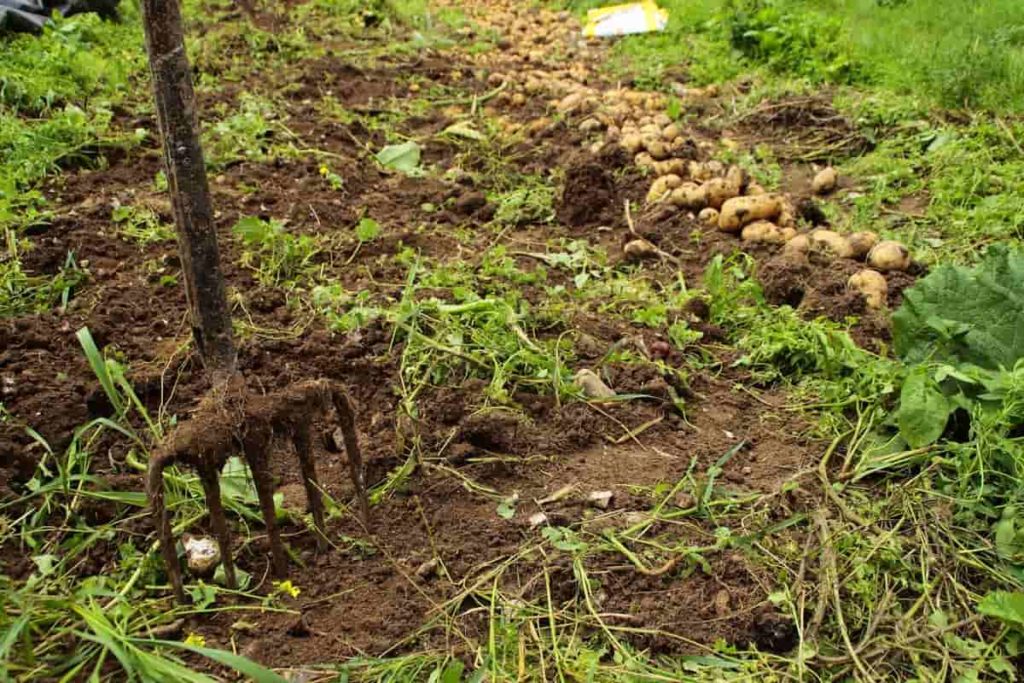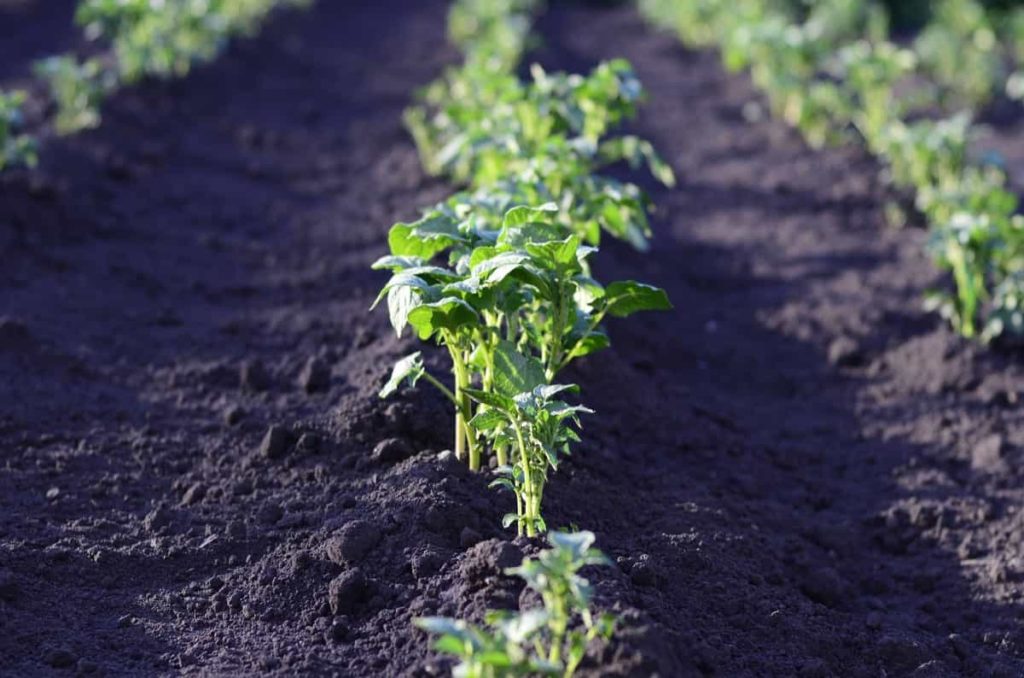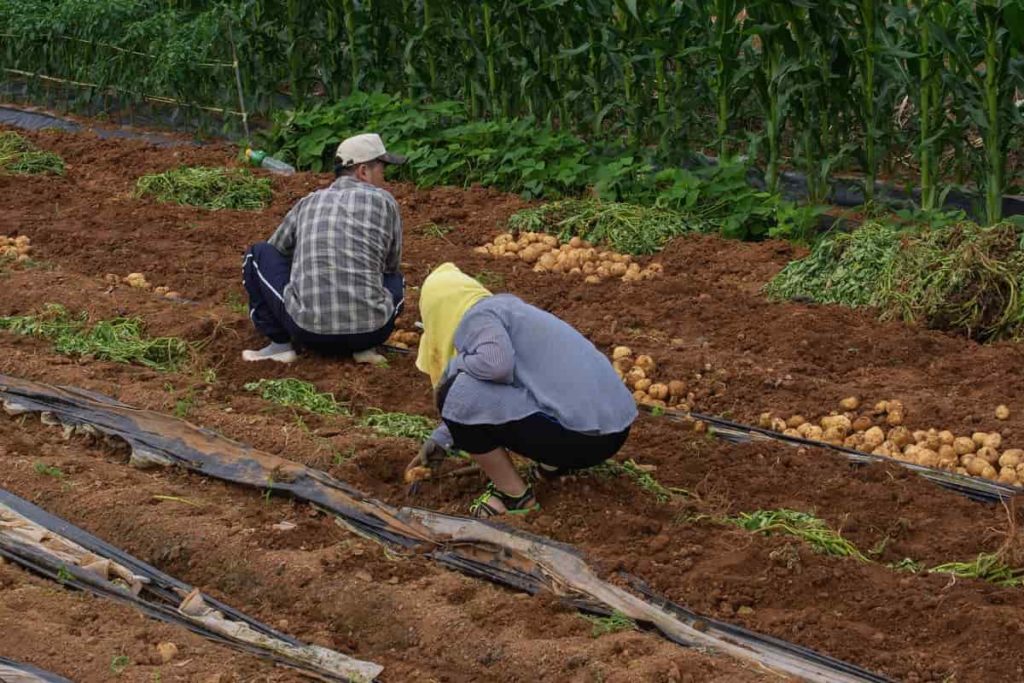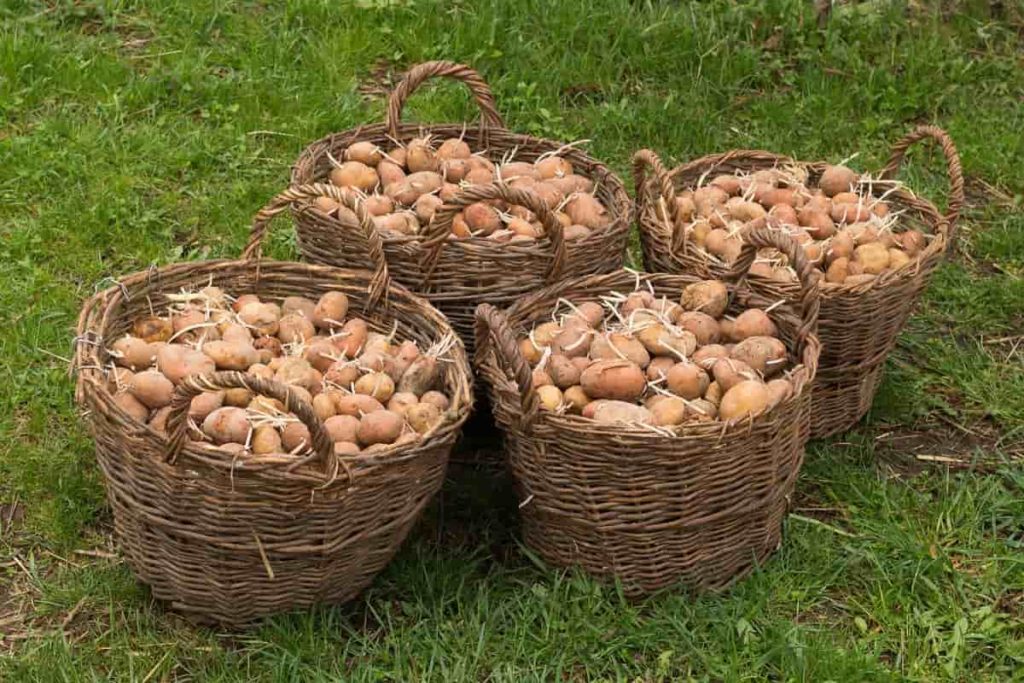Nothing compares to the taste of freshly picked potatoes. Potatoes are simple to cultivate and make a healthy addition to any meal. One medium-sized potato has just 110 calories and is a good source of potassium, iron, vitamin C, and vitamin B6. 2 grams of fibre are provided by eating potatoes with the skins on. These are the benefits of cultivating your potatoes and avoiding the pesticides used on store-bought potatoes.

Potatoes do not require a large amount of garden area. Potatoes can be grown in any location that receives a minimum of 6-8 hours of sunlight. Potatoes can be grown in pots, in the backyard, in grow bags, buckets, and in other containers. Let’s check out a detailed guide to growing potatoes in Texas.
Guide to growing potatoes in Texas
Choosing a type of garden
To grow potatoes in containers in Texas
You can use containers to grow potatoes. Use a bushel basket or huge container, a stock tank, an old trashcan, or a whiskey barrel as a container. If the container doesn’t already have drainage holes, make them. Fill it halfway with high-quality, well-drained potting soil. Add your potatoes, just cover them, and then add additional dirt on top as they develop and sprout.
Potatoes need at least 6-8 hours of sunshine every day to flourish. Potatoes, on the other hand, are a cool-season crop that dislikes the heat. Once the temperature hits the upper 80s F, the plants may stop growing. So, if it’s hot outside, try to put your containers in a spot that gets early light and then gets somewhat covered in the afternoon.
To grow potatoes in the backyard in Texas
Potatoes require full light for optimal growth. They thrive in soil that is loose, well-drained, and somewhat acidic. Poorly drained soils can result in weak stands and yields. Tubers might be tiny and rough if the soil is heavy. Remove any pebbles, garbage, or big sticks from the soil before spading. Spade the soil 8 to 12 inches deep, turning it over to ensure that all plant material is covered. Make beds 10 to 12 inches high and 36 inches apart using the dirt. The importance of bedding in terms of drainage cannot be overstated.
In case you miss this: How to Grow Potatoes in 20 Steps: Secrets, Tips, and Ideas

Best potato varieties that grow in Texas
In North Texas
White potato, red potato, and yellow potato are three typical kinds that grow well in North Texas.
In Central Texas
White potato, Irish potato, red potato, and yellow potato are the most common potato kinds in central Texas.
In South Texas
For the best yield in south texas, plant Red Potatoes, Red LaSoda, and Norlands.
In East Texas
White potatoes, Pontiac (red), Red Lasoda (red), and Norland (red) potato types are recommended for East Texas.
Choosing seed potatoes
Obtaining high-quality seed potatoes is the first step in growing potatoes in Texas. Seed potatoes are similar to store-bought potatoes, with the exception that they are normally disease-free and are not treated with growth inhibitors. It’s critical to plant disease-free potatoes to avoid introducing anything to your garden soil that can create difficulties later.
In case you miss this: Sweet Potato Gardening – How To Start, Tips, and Ideas

Cutting and sizing of seed potatoes
To allow for scabbing, seed potatoes should be clipped at least 2 to 3 days before planting. The scab prevents the seed potato from decaying, which can occur when it is sown right after cutting. If needed, a little powdered sulphur combined with damp peat moss or sawdust can be used to store the chopped potatoes for extended periods. Seed potatoes should be stored in regions that are not exposed to cold temperatures or temperatures above 85 ℉.
Large seed potatoes can be sliced into 2 to 3 ounce and 2 to 3 piece chunks. Depending on the eyes and weight, little seed potatoes can be left whole or chopped once. Large tubers should be cut into block-shaped, 2 to 2 1/2-ounce seed pieces, with 2 to 3 eyes on each piece. Smaller potato seeds may not have enough energy reserve to maintain development, thus cuttings weighing around two ounces are preferred. Using potato chunks that are bigger than two ounces is ineffective. If a freeze-damaged sprout is harmed, suckers will appear in about two weeks below the damaged portion of the sprout.
Soil preparation for containers and backyard gardening
Potatoes are grown in a backyard garden or containers. With a shovel, turn the dirt 6 to 8 inches deep. Dig shallow trenches of 2 to 3 inches deep and 3 to 4 inches wide after leveling the soil with a rake, placing rows 3 to 4 feet apart on centers. With a tiny rake, lightly spread a balanced fertilizer in the trench and mix the fertilizer in the topsoil.
Spacing of chopped potatoes
In the rows, space the chopped seed potatoes 18 to 24 inches apart. Fill the trench to ground level with a rake. Spread the fertilizer evenly over the row, about 18 inches wide. Dig or remove the fertilized dirt from the centers between the rows using a rake or shovel to put another 4 to 6 inches of soil immediately over the row of potatoes. It normally takes 3 to 4 weeks for potatoes to break through the soil surface and grow leaves.
Watering for potatoes in Texas
Potatoes in Texas, for the most part, require very little watering over time. The rains texas gets in the spring are generally enough to yield decent potatoes. There are times when you’ll want to keep an eye on the plants to make sure they don’t dry out too much, or you’ll end up with deformed or split potatoes. When the plant starts to blossom, it is signaling that it is about to enter the bulking phase. This is the time to make sure your plant gets a couple of inches of water every week so it can grow tubers. During this time, inconsistency in watering might result in damaged tubers.
When the plants start to turn yellow, it’s an indication that they’re about to shut down and the tubers are almost ready to harvest. The soil will still need to be kept somewhat moist during this time to preserve the tuber’s integrity, but watering may be drastically decreased. If you want to keep the potatoes for a long period, you can let the plants’ tops die back entirely and stop watering for a few weeks. This will allow the potatoes to heal underground before being dug out and stored.
Fertilizing of potato plants in Texas
When the tubers are developing, the plant needs plenty of water and fertilizer. This normally happens when the plants reach a height of 6 to 8 inches. When the plants are approximately 4 inches tall, apply 1 cup of fertilizer to every 30 feet of the row beside the plants.
In case you miss this: Sweet Potato Growing Tips, Tricks, Ideas, and Secrets

Caring for potato plants in Texas
Above the seed piece, all tubers formed on a potato plant grow. The dirt must be moved toward the plant as it grows since the seed component is only 3 inches deep. This provides a space for the tubers to grow. For this, use heavy mulch. Soft mulch potatoes are usually smoother than those grown in soil. This is particularly true if the earth is compacted.
As the potatoes grow larger, they must be kept out of direct sunlight to avoid becoming green. When the plants are 8 to 10 inches tall, cover them with a heavy layer of mulch to block sunlight, lower soil temperature, and boost production and quality. Flowers and fruits are produced by potato plants regularly. The fruits contain the potato plant’s actual seed. They resemble little tomatoes but are not edible.
Harvesting of potatoes in Texas
Depending on the size and texture of the potatoes you want, you can harvest them at different periods. New potatoes are the tasty, sensitive, thin-skinned potatoes that develop as soon as the plant begins to blossom. Once your potato plants start to blossom, use a soil fork to carefully dig down and collect some or all of the immature potatoes from beneath the plant. Because of their thin shell, these potatoes don’t keep well, but if you plan to consume them within a week or two, they’re wonderful.
Storage potatoes are mature potatoes picked up after the plant’s life cycle has come to an end. The plant will turn yellow and wither once it has finished accumulating starch in the tubers. You may dig up your fully developed potatoes once the plant has died entirely. A shovel or a potato fork can be used to do this. Because tubers can grow outward as well as downward, carefully dig beneath the plant from a considerable distance. You don’t want to dig directly beneath the plant since this will harm some of the tubers.
In case you miss this: Potato Growing Tips, Ideas, Secrets, and Techniques

Disease prevention for potato plants
Potatoes are affected by several diseases. Applying a fungicide to seed pieces before planting might be beneficial. If diseases occur, inspect the plants frequently and treat them with an authorized fungicide. Fungicides such as neem oil, sulphur, and others are available. Always read and follow the advice on the label.
Most potato diseases can be controlled with a good rotation scheme. If at all possible, avoid planting potatoes in the same spot more than once every three years. Potatoes should not be served with eggplant, okra, pepper, or tomato. If your garden is too small for appropriate rotation, seed piece treatment is very crucial.
Frequently asked questions
Can you grow potatoes year-round in texas?
Potatoes are planted in two cycles in Texas. The first takes place in the winter, from February until mid-March. The second round takes place in the summer, from August through September. The primary crops with the highest yield are those that are grown in the winter. We can also grow potatoes in the greenhouse beds during winter, bringing them forward several weeks due to the increased protection.
Can you grow potatoes in winter in texas?
Potatoes are a fantastic winter-early spring crop, and you can get seed potatoes at local garden shops and on the internet at this time of year. And there’s a potato planting option for every garden size! Plant them in rows or mounds on the ground, in containers, or backyard of your house. Potato bags are available at garden centers and are made from cloth.
Potatoes are a crop that grows best in the cooler months. Temperatures of 60° to 65° F, with a high of 80° F, are ideal for vine growth. When the soil temperature reaches 45 degrees, tubers will begin to develop. When soil temperatures hit 75°F, tuber development is inhibited and eventually ceases at 85°F. The vines are delicate and will be harmed by frost at temperatures below 30°F.
Potatoes require 90-120 days to mature, depending on the type, however, little potatoes can be harvested after 60-70 days. With this information in mind, it’s reasonable to state that mid-February is a decent time to start planting potatoes, even if the winter is mild. Potatoes will not sprout if the soil temperature is less than 40 degrees Fahrenheit.
In case you miss this: Growing Baby Potatoes In Pots – Indoors At Home

In such chilly temperatures, even if the potato has already sprouted, growth will be sluggish. Potatoes that are grown too early in the season are vulnerable to late spring frosts, in addition to having a poor development rate. Although a plant that has been harmed by the cold can still produce new growth, it will do so at a high cost in terms of energy.
Can you grow potatoes in summer in texas?
Tubers will not form or the plant’s growth will be inhibited if the temperature is too high in the summer. When the temperature drops below 86 degrees Fahrenheit, fewer roots develop and tuber production almost stops. In summers you can use row covers for planting potatoes. A row cover is a large piece of cloth that covers a whole row of plants at once. A row cover protects from the cold and heat, also if the ends of the row are closed, it can help keep pests and predators out.
Even if a row cover is hung on a plant, frost damage can occur where the cloth meets the plant. Installing supports in a row is one approach to avoid this. Wrap the row cover around the supports after that. For example, you can make a half-circle using a flexible plastic rod and push the ends into the ground. Place your half-circles in a row two feet apart, then cover them with the row cover to create a small “hoop house.” Your potato plants will benefit from a few degrees of heat protection provided by row coverings. This can help the plants’ tops survive high temperatures.
These are some of the heat-tolerant potato varieties to grow in texas in summer, red Cloud is a mid-season potato with a red exterior and white meat that yields spherical tubers. It is also drought resistant. Superior is a light brown-skinned early-season potato with white meat. It is also drought resistant. Viking Red is a mid-season potato that produces red-skinned tubers with white meat. It is also drought resistant.
- Broccoli Seed Germination and Selection
- Asparagus Seed Germination and Variety Selection
- Seasonal Flower Gardening: Best Practices for Spring, Summer, Fall, and Winter
- How to Grow Hibiscus from Flower
- Plantation Ideas for Home Decoration: A Beginners Guide
- Flower Garden Designs and Layouts for Beginners
- Planting and Spacing Techniques in Papaya: A Beginner’s Guide
- Growing Gold: Essential Techniques for Planting Pineapples
- How to Make Kalanchoe Plant Bushy: Home Remedies and Solutions
- 11 Reasons Why Your Gardenia is Not Blooming: Home Remedies and Solutions
- Eco Elegance: The Guide to Designing a Drought-Tolerant Landscape
- Gardening on a Slope: Strategies for Hillside Landscaping
- Nourish and Flourish: Top Organic Mulches for Thriving House Plants
- Everything You Want to Know about Indian Mogra Flower: Discover Uses and Growing
- Green Thumb Success: Expert Tips for Cultivating Greenhouse Pumpkins All Year Round
- Maximize Growth & Flavor: The Ultimate Guide to Companion Planting in Herb Gardens
- How to Control Rhododendron Problems Naturally: Home Remedies and Organic Ways to Fix Them
- Natural Magic: The Remarkable Benefits of Cinnamon for Plants
- Best Steps to Revive Dying Tulip with Natural and Organic Treatment
- 10 Reasons Why Your Angel Trumpet is Not Blooming: Remedies and Treatment
- How to Fix Periwinkle Leaf and Flower-Related Problems: Natural Remedies and Solutions
- How to Fix Zinnias Leaf and Flower Problems: Discover Natural and Home Remedies
- Organic Steps to Induce Lemon Tree Flowers: A Comprehensive Guide
- Bloom Booster: Crafting the Perfect Homemade Bougainvillea Fertilizer
- Optimizing Growth: A Guide to Applying NPK Fertilizer for Potted Plants
- 10 Best Homemade Fertilizers for Rubber Plant: DIY Recipes and Application Method
- How to Boost Female Pumpkin Flowers: Effective Steps for More Flowers and High Yields
- Transform Your Indoor Garden: Top Benefits of Pink Salt for Houseplants
- 10 Best Homemade Fertilizers for Peacock Plants (Calathea): Easy DIY Guide
- Unlock Blooms: 9 Reasons Why Your Potted Chrysanthemum is Not Blooming
- 8 Reasons Why Your Potted Hibiscus is Not Blooming: Fix it with Simple Solutions
- Unlock Blooms: 9 Key Reasons Your Potted Frangipani Won’t Flower
- 10 Reasons Why Is My Ice Plant Not Blooming: Remedies and Treatment
- 10 Reasons Why My Potted Hydrangea Not Blooming: Treatment and Remedies
- 10 Reasons Why is My Wisteria Not Blooming: Remedies and Treatment
- 10 Reasons Why is My Goldfish Plant Not Blooming: Remedies and Treatment